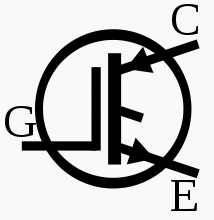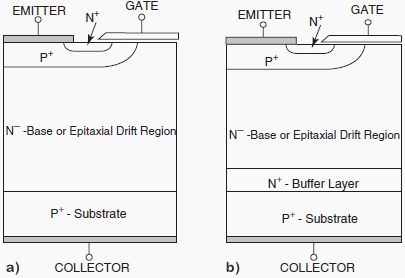 The IGBT has the high input impedance and high-speed characteristics of a MOSFET with the conductivity characteristic (low saturation voltage) of a bipolar transistor. The IGBT is turned on by applying a positive voltage between the gate and emitter and, as in the MOSFET, it is turned off by making the gate signal zero or slightly negative.
The IGBT has the high input impedance and high-speed characteristics of a MOSFET with the conductivity characteristic (low saturation voltage) of a bipolar transistor. The IGBT is turned on by applying a positive voltage between the gate and emitter and, as in the MOSFET, it is turned off by making the gate signal zero or slightly negative.
The IGBT has a much lower voltage drop than a MOSFET of similar ratings.
The structure of an IGBT is more like a thyristor and MOSFET. For a given IGBT, there is a critical value of collector current that will cause a large enough voltage drop to activate the thyristor. Hence, the device manufacturer specifies the peak allowable collector current that can flow without latch-up occurring. There is also a corresponding gate source voltage that permits this current to flow that should not be exceeded. Like the power MOSFET, the IGBT does not exhibit the secondary breakdown phenomenon common to bipolar transistors.
However, care should be taken not to exceed the maximum power dissipation and specified maximum junction temperature of the device under all conditions for guaranteed reliable operation. The on-state voltage of the IGBT is heavily dependent on the gate voltage. To obtain a low onstate voltage, a sufficiently high gate voltage must be applied.
In general, IGBTs can be classified as punch-through (PT) and nonpunch-through (NPT) structures, as shown in Figure below. In the PT IGBT, an Nþ buffer layer is normally introduced between the P+ substrate and the N¯ epitaxial layer, so that the whole N¯ drift region is depleted when the device is blocking the off-state voltage, and the electrical field shape inside the N¯ drift region is close to a rectangular shape.
Because a shorter N¯ region can be used in the punch-through IGBT, a better trade-off between the forward voltage drop and turn-off time can be achieved. PT IGBTs are available up to about 1200 V.


High voltage IGBTs are realized through a nonpunch-through process. The devices are built on an N¯ wafer substrate which serves as the N¯ base drift region. Experimental NPT IGBTs of up to about 4 KV have been reported in the literature. NPT IGBTs are more robust than PT IGBTs, particularly under short circuit conditions. But NPT IGBTs have a higher forward voltage drop than the PT IGBTs. The PT IGBTs cannot be as easily paralleled as MOSFETs.
The factors that inhibit current sharing of parallel-connected IGBTs are (1) on-state current unbalance, caused by VCE(sat) distribution and main circuit wiring resistance distribution, and (2) current unbalance at turn-on and turn-off, caused by the switching time difference of the parallel connected devices and circuit wiring inductance distribution.
The NPT IGBTs can be paralleled because of their positive temperature coefficient property.
SOURCE: Kaushik Rajashekara – Delphi Automotive Systems






